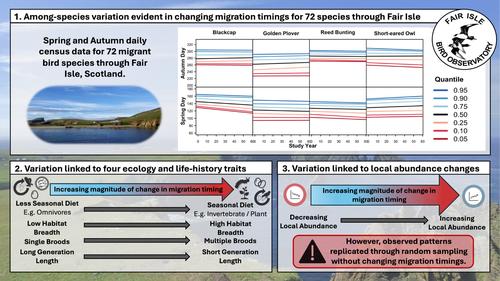当前位置:
X-MOL 学术
›
Glob. Change Biol.
›
论文详情
Our official English website, www.x-mol.net, welcomes your
feedback! (Note: you will need to create a separate account there.)
Among‐species variation in six decades of changing migration timings explained through ecology, life‐history and local migratory abundance
Global Change Biology ( IF 10.8 ) Pub Date : 2024-07-15 , DOI: 10.1111/gcb.17400 Vicki R Dale 1 , Mark Bolton 2 , Maria Dornelas 3 , Anne E Magurran 3 , Roy Dennis 2, 4 , Roger Broad 2 , Nick J Riddiford 2 , Paul V Harvey 2 , Roger Riddington 2 , Deryk N Shaw 2 , David Parnaby 2 , Jane M Reid 1, 2, 5
Global Change Biology ( IF 10.8 ) Pub Date : 2024-07-15 , DOI: 10.1111/gcb.17400 Vicki R Dale 1 , Mark Bolton 2 , Maria Dornelas 3 , Anne E Magurran 3 , Roy Dennis 2, 4 , Roger Broad 2 , Nick J Riddiford 2 , Paul V Harvey 2 , Roger Riddington 2 , Deryk N Shaw 2 , David Parnaby 2 , Jane M Reid 1, 2, 5
Affiliation

|
Species exploiting seasonal environments must alter timings of key life‐history events in response to large‐scale climatic changes in order to maintain trophic synchrony with required resources. Yet, substantial among‐species variation in long‐term phenological changes has been observed. Advancing from simply describing such variation towards predicting future phenological responses requires studies that rigorously quantify and explain variation in the direction and magnitude of changing timings across diverse species in relation to key ecological and life‐history variables. Accordingly, we fitted multi‐quantile regressions to 59 years of multi‐species data on spring and autumn bird migration timings through northern Scotland. We demonstrate substantial variation in changes in timings among 72 species, and tested whether such variation can be explained by species ecology, life‐history and changes in local abundance. Consistent with predictions, species that advanced their migration timing in one or both seasons had more seasonally restricted diet types, fewer suitable breeding habitat types, shorter generation lengths and capability to produce multiple offspring broods per year. In contrast, species with less seasonally restricted diet types and that produce single annual offspring broods, showed no change. Meanwhile, contrary to prediction, long‐distance and short‐distance migrants advanced migration timings similarly. Changes in migration timing also varied with changes in local migratory abundance, such that species with increasing seasonal abundance apparently altered their migration timing, whilst species with decreasing abundance did not. Such patterns broadly concur with expectation given adaptive changes in migration timing. However, we demonstrate that similar patterns can be generated by numerical sampling given changing local abundances. Any apparent phenology‐abundance relationships should, therefore, be carefully validated and interpreted. Overall, our results show that migrant bird species with differing ecologies and life‐histories showed systematically differing phenological changes over six decades contextualised by large‐scale environmental changes, potentially facilitating future predictions and altering temporal dynamics of seasonal species co‐occurrences.
中文翻译:

通过生态学、生活史和当地迁徙丰度解释了六年来不断变化的迁徙时间的物种间差异
利用季节性环境的物种必须改变关键生活史事件的时间,以应对大规模的气候变化,以保持与所需资源的营养同步。然而,已观察到长期物候变化存在显着的物种间差异。从简单地描述这种变化到预测未来的物候反应,需要进行严格量化和解释与关键生态和生活史变量相关的不同物种变化时间的方向和幅度的研究。因此,我们对 59 年关于苏格兰北部春季和秋季鸟类迁徙时间的多物种数据进行了多分位数回归。我们证明了 72 个物种之间时间变化的巨大差异,并测试了这种差异是否可以用物种生态、生活史和当地丰度的变化来解释。与预测一致的是,在一个或两个季节提前迁徙时间的物种具有更多季节性限制的饮食类型、更少的合适繁殖栖息地类型、更短的世代长度以及每年产生多个后代的能力。相比之下,饮食类型受季节限制较少且每年产卵的物种则没有表现出任何变化。与此同时,与预测相反,长途和短途移民同样提前了移民时间。迁徙时间的变化也随着当地迁徙丰度的变化而变化,季节性丰度增加的物种明显改变了它们的迁徙时间,而丰度减少的物种则没有。鉴于迁移时间的适应性变化,这种模式大致符合预期。 然而,我们证明,考虑到局部丰度的变化,可以通过数值采样生成类似的模式。因此,任何明显的物候-丰度关系都应该仔细验证和解释。总体而言,我们的研究结果表明,具有不同生态和生活史的候鸟物种在过去六年中在大规模环境变化的背景下表现出系统不同的物候变化,这可能有助于未来的预测并改变季节性物种共现的时间动态。
更新日期:2024-07-15
中文翻译:

通过生态学、生活史和当地迁徙丰度解释了六年来不断变化的迁徙时间的物种间差异
利用季节性环境的物种必须改变关键生活史事件的时间,以应对大规模的气候变化,以保持与所需资源的营养同步。然而,已观察到长期物候变化存在显着的物种间差异。从简单地描述这种变化到预测未来的物候反应,需要进行严格量化和解释与关键生态和生活史变量相关的不同物种变化时间的方向和幅度的研究。因此,我们对 59 年关于苏格兰北部春季和秋季鸟类迁徙时间的多物种数据进行了多分位数回归。我们证明了 72 个物种之间时间变化的巨大差异,并测试了这种差异是否可以用物种生态、生活史和当地丰度的变化来解释。与预测一致的是,在一个或两个季节提前迁徙时间的物种具有更多季节性限制的饮食类型、更少的合适繁殖栖息地类型、更短的世代长度以及每年产生多个后代的能力。相比之下,饮食类型受季节限制较少且每年产卵的物种则没有表现出任何变化。与此同时,与预测相反,长途和短途移民同样提前了移民时间。迁徙时间的变化也随着当地迁徙丰度的变化而变化,季节性丰度增加的物种明显改变了它们的迁徙时间,而丰度减少的物种则没有。鉴于迁移时间的适应性变化,这种模式大致符合预期。 然而,我们证明,考虑到局部丰度的变化,可以通过数值采样生成类似的模式。因此,任何明显的物候-丰度关系都应该仔细验证和解释。总体而言,我们的研究结果表明,具有不同生态和生活史的候鸟物种在过去六年中在大规模环境变化的背景下表现出系统不同的物候变化,这可能有助于未来的预测并改变季节性物种共现的时间动态。
















































 京公网安备 11010802027423号
京公网安备 11010802027423号